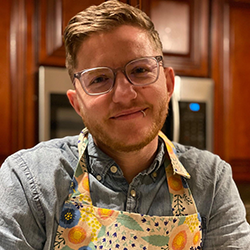On Sara Moulton
What is it about watching white women teach me to cook? On nights while Anna works I watch them. Alison Roman makes a chicken caesar wrap. Carla Lalli Music makes a chicken caesar wrap. Molly Baz makes a chicken caesar sandwich. I’m probably never going to make any of these elaborate hand-held foods, but I watch standing at the counter doing mundane chores, wiping things, drying things, and I watch standing at the dining room table folding load after load after load of laundry. Two enormous stacks of dishtowels, a number of piles for each person in the house: one for pants, one for shirts, one for underwear. The eight-seater table has become a landscape of stacks. Anna likes to work nights. She started when she was pregnant with our first, and it’s how we learned to co-exist, all that space. When she is on nights I sleep propped up by all four of our pillows. As a kid, I watched women cook, too. I liked Rachael Ray, her earnestness, the way the ingredients were things my mother would have had in the house. 30 Minute Meals, which aired the year I was in the eighth grade, featured a frenzied series of actions: running to the cupboard for bags of pasta or grains, patting dry meat, opening giant cans. She talked fast, too, in an almost pressured way, but friendly, too. She reminded me of a younger, kinder version of my mother making dinner. I liked that my mother, who grew up in a home with no good cooks and not enough money, could carry on a lively conversation while performing all of the kitchen’s actions. Making dinner every day for so many people had made a cook out of her. She poured vegetable oil and vinegar and a packet of dressing mix into a little bottle and shook it vigorously. She cut onion into bits with a little steak knife. She breaded chicken cutlet after chicken cutlet after chicken cutlet and the whole time, she talked.
As a teenager, I watched Sara Moulton because she was so smart about food, and even though she often made accessible dishes on her shows, especially on Sara’s Secrets, she had worked in restaurants and as a recipe developer and editor for Gourmet, so she could explain why she did the things she did, and what was important to spend time and money on. My mother treated food television as background fodder, something that was on but only half paid attention to. I learned from her that when you do the work of the home, you listen to the work of the home.
The house in which I grew up was impossibly loud: my mother was loud, my five siblings were loud, our dogs were loud. First we were in a very small home, the downstairs of a duplex in which our bodies were always on top of each other, sitting in front of the window A/C in the living room eating firecracker popsicles, and then we were in a much larger, more echoey home, my mother’s yelling reverberating off every wall. She would yell between two and four names, on average, before saying the one she’d originally meant to shout.
I liked that the women on television, the women teaching us to cook, talking to us while we did chores, were not yelling. They never cursed or demanded anything of me. Their gentle suggestions were offered with something I suppose I mistook for love.
I love my mother, and as I’ve gotten older and had my own family I understand her so much more, but I admittedly spent my youth looking for other mothers, for women who would talk calmly to me, who had warm faces.
I spend a good deal of time trying to remember if wanted children when I was a young child. I can’t figure it out. When did that desire come in? There is no remembered time in which my mother wasn’t mothering at least one child other than me. Feeding us took up an enormous amount of her time. My mother did not work outside the home, and so we were the work of her life. She never pressured me to have children. Nobody wants or expects queers to do it. I didn’t know I was a queer child. I didn’t know what that was. All I knew was, whatever my mother had, this life of cooking and cleaning, it didn’t seem like something I was supposed to want, supposed to get.
Sara Moulton’s debut cookbook is the first one I remember seeing on the shelf at Barnes & Noble. On the cover of Sara Moulton Cooks at Home she wears a modest blue scoop-neck shirt and an orange apron.
The apron is emblazoned with the logo for her show: sara’s secrets, it says, humbly, in lowercase blocky print.
On Cooking Live, Sara Moulton wears chef’s coats. They look trim and professional on her small, blond body: she looks like a seasoned athlete, the kitchen her playing field. Her moves are planned out. She has great bangs. Not many clips from this show remain on the internet, but when I watch them as a thirty-six year old man, I notice things I didn’t remember but am certain I observed, integrated, as a child: the big rolled up sleeves on her blue chef’s coat, her sporty ponytail, the natural, if present at all, makeup on her face.
I didn’t know people could transition until I was seventeen years old. I know it’s weird, because I grew up in New Jersey, and could see the New York City skyline on my way to high school, down Route 17, but it just wasn’t something I’d ever heard of until I was getting ready to go to college. Lesbian was as far as queer went in my parochial high school. So when I looked for models of what kind of adult I could be, I looked for women with haircuts like Moulton, women who, because of their professions, had to wear sensible shoes at all times.
Whether someone was, or is, actually gay, that doesn’t matter. It was about finding models of success whose costumes looked like something I wouldn’t rather die than wear.
In her Cooking Live episode Burgers, Moulton speaks authoritatively but casually about ground lamb, an ingredient many American home cooks twenty years ago might have found unusual. She explains how to ask a butcher for a better grind, but acknowledges that interacting with a butcher isn’t something most of us can do, bound to the supermarket as we are.
She speaks in relatable aphorisms. Take it home, season it, cook it right up, you’re in business.
Sara Moulton is a good teacher. She knows how to explain techniques and ingredients in a way that beginners and more seasoned cooks would understand. If she thinks an ingredient might not be at a supermarket, she tells you where to get it. In a 55 minute episode, she makes three different burgers: a lamb burger served in a pita, a chili cheeseburger, and a tuna burger.
Like my mother, I have learned that the most likely successes in the kitchen, when you’re cooking for your family, are slight variations on things they already like. Thus, something that looks like a beef cheeseburger, that is called a burger, is almost guaranteed to work.
Sitting at a table with three gigantic dressed burgers and a modest glass of wine, Sara Moulton concludes the episode by answering questions from fans.
This is where Moulton, like any great teacher, shines: responding to these inquiries with care and automaticity. She still does this today: on Christopher Kimball’s podcast Milk Street Radio, Moulton joins Kimball in a weekly Q&A segments. Listeners call in with all kinds of questions, but the ones I like best are from people trying to reconstruct family recipes. The callers described what a cake looked and tasted like, and Moulton and Kimball offer advice on resurrecting a dormant, grandmotherly joy.
In one episode, a caller named Jerry from Vermont describes his family’s annual viewing of the 1983 made for TV holiday film The Gift of Love. In one scene, Jerry relates, Angela Lansbury’s character proclaims that she is going to make her famous burnt orange cake. What could that be?
Wow, Moulton says. I’ve never heard of this before, though it sounds absolutely wonderful. Though Christopher Kimball says he believes the burnt orange refers to the color, and he may be actively googling while he relates this fact, Moulton seems delighted by the question and its ascendant possibilities, and on the spot invents a dreamed-up treat: I envision, she says, a wonderful orange cake that you then pour a dark caramel syrup over, and just let it infuse.
Jerry likes that idea, he says.
Nobody transcribes these episodes, so I don’t know how to spell the question-asker’s name. I suppose I’ve chosen Jerry with a J to distance him from Gerry with a G, my father, who rarely prepared food for the family, though, on the rare occasions he did, he was quite skilled in the kitchen.
In a 2022 interview with Benjamin Kemper, Moulton is asked about the gender divide in cooking—those who light things on fire (Emeril Lagasse, Bobby Flay), vs. those who help Mom get dinner on the table, Moulton answers flatly on the dynamics of early cable food television:
They didn’t really want women at Food Network.
Cooking Live ran for over 1,200 episodes. In her next show, Sara’s Secrets, which ran for just three years, Moulton dresses differently. She wears what my stay-at-home mother wore: basic slacks and workmanlike long-sleeve tee shirts, tight on the whole body, covered by a plain aprons. She is presented, then, as a regular person, not a professional, cooking on a homey set in front of some windows. There’s something more feminine about her presentation here, though I am not sure feminine is the right word, and I don’t consider Moulton to be in a certain category among hot white woman television chefs—Claire Robinson of 5 Ingredient Fix, Katie Lee of The Kitchen and Beach Bites with Katie Lee—all, perhaps, Nigella Lawson derivatives in their own ways. The long-sleeve tees, though, lack the gender ambiguity of a loose-fitting chef’s apron. Of all the items of clothing in the world, it was a tight girls’/women’s tee shirt that gave me the most trouble growing up.
In the Kemper interview, Moulton recalls cooking her first meal on a solo television spot. Cooking on one’s own is markedly different from cooking with a host, she tells Kemper.
For my pilot I cooked fish meunière and asparagus—and never once smiled.
Don’t smile until Christmas, the popular teaching adage goes.
Hi, I said on my first day teaching high school. I’m Ms. McIlraith.
Of course I could not help it—I smiled at my students.
We’ll have you out by November, someone said from the back of the room.


Krys Malcolm Belc is the author of The Natural Mother of the Child: A Memoir of Nonbinary Parenthood (Counterpoint 2021) and the flash essay collection In Transit (The Cupboard Pamphlet). He is the memoir editor of Split Lip Magazine and the Edelstein-Keller Writer-in-Residence at the University of Minnesota. Krys lives in St. Paul with his partner and their four young children and is working on a very, very long essay about food.

